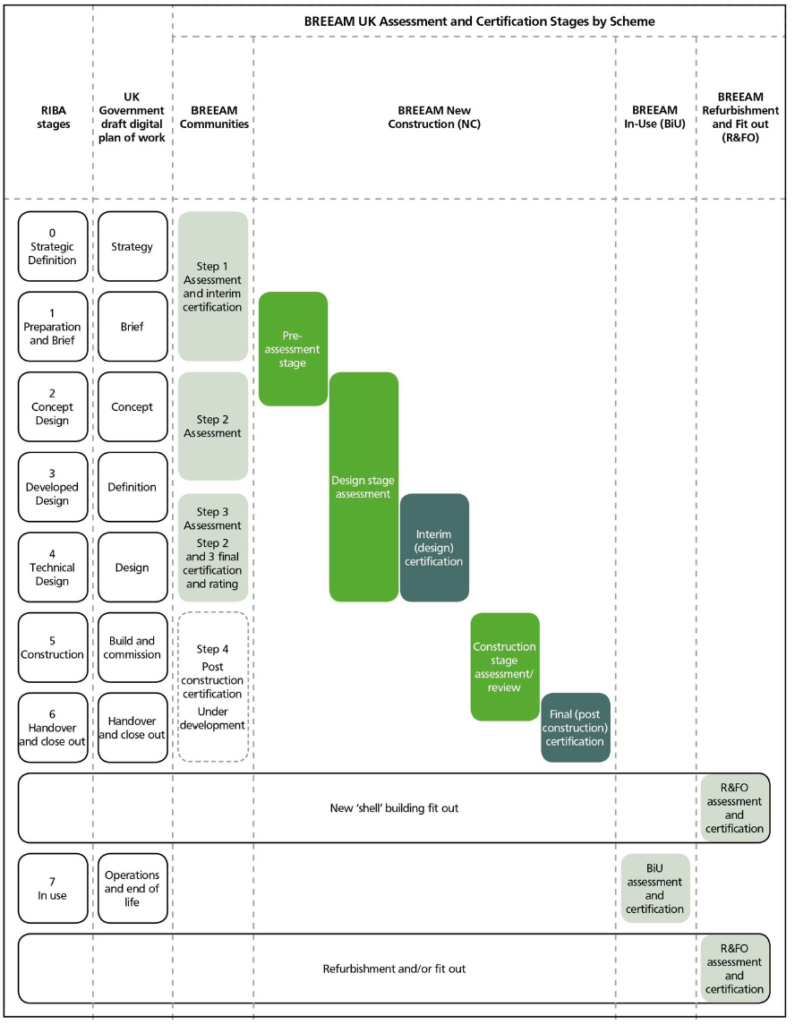Engagement
Early engagement with the BREEAM UK New Construction (NC) scheme and appointment of a licensed Assessor is important to achieve optimal integration of the methodology into the new-build procurement process. At this early stage, the performance of the building and the desired BREEAM rating can be achieved while there is greater flexibility and choice in design solutions and spending decisions.
The table BREEAM stages below (extracted from the technical manual) shows the link between the BREEAM UK NC assessment and certification stages and the RIBA Outline Plan of Work 2013.

Clients can use this to understand when they should ideally engage with BREEAM and appoint a BREEAM Advisory Professional (AP) and BREEAM Assessor.
Orientating the brief towards BREEAM needs to come first and foremost from the client. BRE recommends engagement with a licensed BREEAM Assessor and BREEAM AP no later than the Preparation and Brief stage (RIBA Stage 1 or equivalent) and ideally sooner.
This will ensure that realistic targets are set and can be met, appropriate responsibilities can be defined and understood and low or no cost solutions to environmental impacts can be sought and applied wherever possible.
Performance
Category weightings (image below) are fundamental to any building environmental assessment method providing a means of defining and ranking the relative impact of environmental issues. BREEAM uses an explicit weighting system to determine the overall BREEAM score.
There are a number of elements that determine the overall performance of a new construction project assessed using BREEAM. They are:
- The BREEAM rating level benchmarks
- The minimum BREEAM standards
- The environmental section weightings
- The BREEAM assessment issues and credits
BREEAM rating broadly represents performance equivalent to:
- Outstanding: Less than the top 1% of UK new non-domestic buildings (innovator)
- Excellent: Top 10% of UK new non-domestic buildings (best practice)
- Very Good: Top 25% of UK new non-domestic buildings (advanced good practice)
- Good: Top 50% of UK new non-domestic buildings (intermediate good practice)
- Pass: Top 75% of UK new non-domestic buildings (standard good practice)
The table BREEAM rating below presents the score needed to achieve the desired performance. The figure in this page shows the category weightings for each issue.
Timeline and Costs Implications
The BREEAM UK New Construction Scheme can be used to assess and rate the environmental impacts arising from a newly constructed building development (including external site areas), at the following life cycle stages:
- New Build Design Stage (DS) (optional) – leading to an Interim BREEAM rating and certificate of assessment
- New Build Post-Construction Stage (PCS) – leading to a Final BREEAM rating and certificate of assessment
- New Build Post-occupancy stage (POS) (optional) – leading to a certification relating to robust best practice, to meet design aspirations, in the following areas:
a. post occupancy handover and commissioning processes
b. performance monitoring
c. actions undertaken post occupancy to understand and manage the actual performance of the building.
To assist with optimising project sustainability performance, the BREEAM assessment timeline and costs implication outlines the stage at which credits should be addressed and the costs implications.
Ideally these should be considered by the design team, planner, contractors, owners, occupiers and other members of the project team to achieve the highest possible BREEAM rating at the minimum cost.
If BREEAM advice is taken on too late within the design and construction phases a number of BREEAM credits may not be achieved or only at additional cost or disruption.
Conclusion
In conclusion, careful consideration to when to appoint the BREEAM assessor or BREEAM AP is very important and will reflect the BREEAM target as well the construction and design costs.
For more information about our BREEAM Assessments click here.
This blog has been extracted and adapted from BREEAM UK New Construction, Non-domestic Building (United Kingston), Technical Manual, SD5078 – BREEAM UK New Construction 2018 v. 3.
Download the Timeframe and Costs Implication table here.
Please email us on info@sustainquality.co.uk or call on 01372 438039.
About Us
We are a friendly team of Engineers delivering Sustainability and Building Compliance Solutions for developments in the Commercial and Residential sectors, which include Energy Statements, Noise Impact and Vibration Assessments, BREEAM Assessments, and Air Quality Assessments in the Environmental, Social and Governance sectors.
Contact us at:
Sustain Quality Ltd
PO Box 393
COBHAM
KT11 3EL
info@sustainquality.co.uk
01372 438039